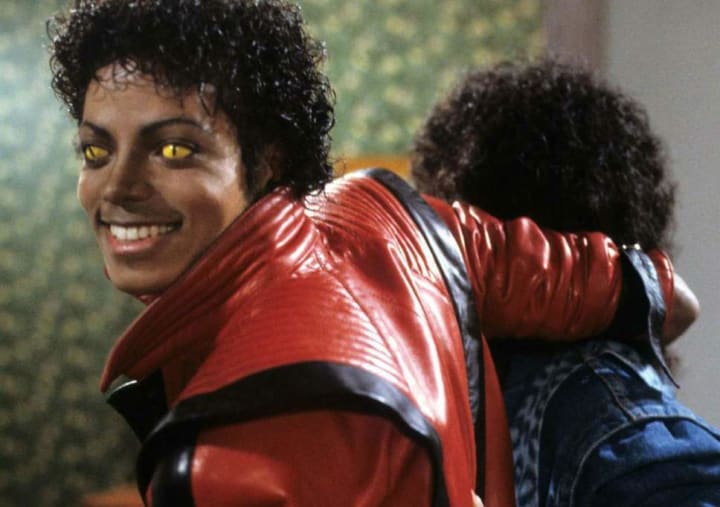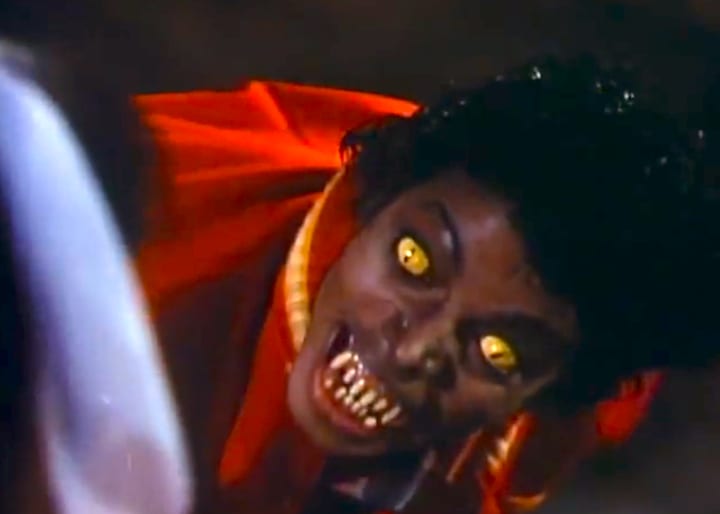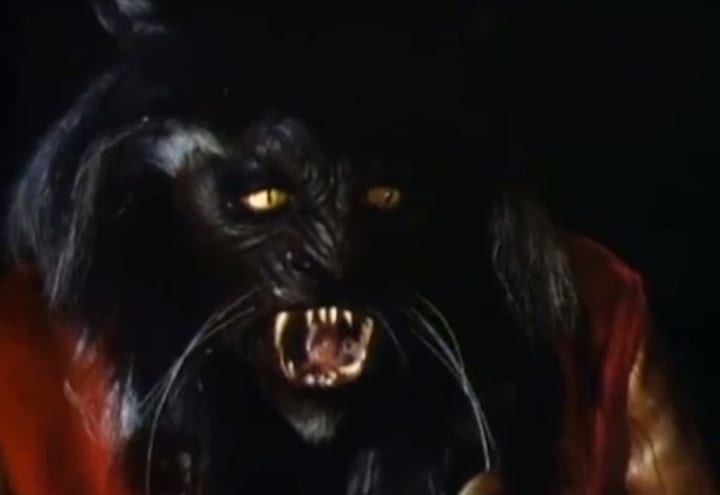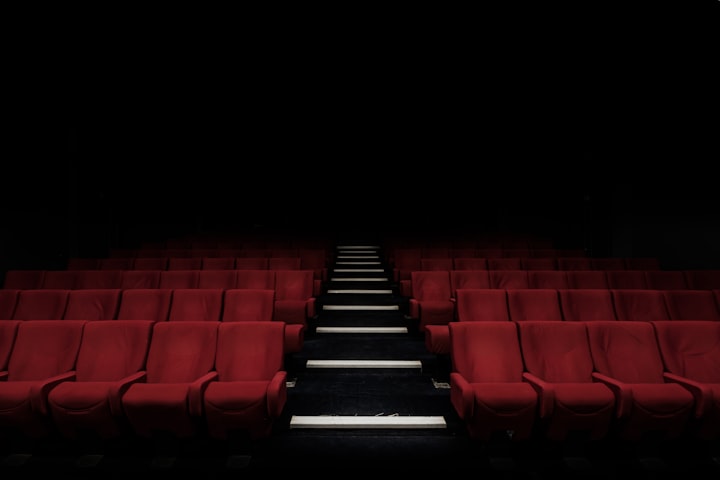A Filmmaker's Guide to the Horror Techniques Used in 'Michael Jackson's Thriller'
Study, Analysis, and Experience

(Note: this article heavily draws on and analyses the short film, Michael Jackson's Thriller. In order to get the best insight of this article it is recommended that you watch the entire film at least once).
Possibly the most recognised music video of all time, Michael Jackson's Thriller is rightly named by the King of Pop himself as one of his "short films" instead of an actual music video. This is rightly so as this is not just a video about music; this is a story with themes, symbolism, and harbouring severe cultural significance. Bouncing off the cult horror classic An American Werewolf in London and the Robert Burns poem,Michael Jackson hired American Werewolf's actual director, John Landis, to endue the greatest "short film" ever made with life.
In this article we're going to have a look at four main themes that are included, explored and interwoven with each other and these are:
- Normality vs. Abnormality
- Darkness
- Colour Scheme
- Fear
1. Normality vs. Abnormality

A Still from "Michael Jackson's Thriller"
Normality vs. Abnormality is a huge part of Michael Jackson's Thriller as it brings Michael Jackson into becoming the main character of this story of fear. A perfectly normal man is portrayed by Jackson and then, we have the werewolf, the zombie character, and then, this finale before the credits and the graveyard scene begins for a second time. This seems to finalise the audience's thoughts about the character by confirming that yes, he is a werewolf or a zombie of some kind. Let's take a look at the frame in its detail.
In this frame we see that mostly everything is very much normal. Michael Jackson picks up Ola Ray from the sofa and they begin to walk out of the house when Michael Jackson turns around towards the camera to show us these glowing yellow eyes. These yellow eyes are the only outstanding and abnormal objects of this particular frame and, in fact, they are made to look a lot more malevolent than they actually are. This is done by the following:
- The background offset to green which enhances the colour of the yellow
- The contrast with the bright red jacket which enhances the brightness of the yellow
- The fact that there is a clear good amount of light in the room which does not make the brighter colours stand out over the eyes and thus, makes the eyes look as abnormal in the setting as physically possible
Here's a tip: when using this kind of frame, make sure that there is nothing else that looks in any way abnormal. This will make the singular abnormality stand out. You can definitely use this frame for a starting point because, as we know, it is a brilliant frame.
Here's another tip: don't have too many complete contrast colours because it will drain out the colour you're actually trying to work with. Looking at this frame, we don't see the colour purple at all (which is the contrast colour of yellow). Instead, we see colours that are close to and enhance the yellow, like red and green.
2. Darkness

A Still from "Michael Jackson's Thriller"
It is well documented that this film gets its darkness usages from Landis' other cult horror, An American Werewolf in London. But, who knew that whilst there are three main ways in which darkness is used in Landis' cult film, there are in fact four in Michael Jackson's Thriller. And yes, it is time to look at all four of them individually and pick them apart for reasoning and analysis. The four types of darkness are:
- Atmospheric
- Night
- Suggestion
- Secondary Characters and Physical Traits
We're first going to take a look at the "Atmospheric Darkness" used in the frame above:
The atmosphere of a cinema is created by the fact that the room is very, very dark and not much can be seen. This is only enhanced by the fact that Michael Jackson seems to be wearing the brightest colours in the room. The bright red not only makes the character stand out, but it also makes the darkness look and feel darker. The only light source in coming from directly in front of the audience watching the screen and therefore, those sitting in the middle to the back will not be as well lit as those in the front. This means that the placing of Michael Jackson and Ola Ray was very important in making sure that the audience could see them but the atmosphere of the scene was retained by the amount of darkness.
Now, we're going to have a look at a frame that shows us the use of night in the film to portray darkness:
Frame 2

A Still from "Michael Jackson's Thriller"
Let's have a look at this frame that uses night.
Night is a huge way of using darkness in any horror film, but in this one it hold particular significance. This is because when the pair come out of the cinema, we don't get the light of the sun, we actually realise that it's night-time and this association with the movie they have just watched makes the feeling of that particular night very uneasy.
If you look for the light source in this scene, you may be able to find it as it is on your right coming in from the side of the screen which is suggestive of an artificial light source. This artificial light source could be a building or a streetlamp etc. But, notice how it lights up as much of the frame as it needs to, again, not harming the effect of the dark nightly atmosphere.
The light source also creates the same foggy and misty atmosphere seen in the film An American Werewolf in London. I'm thinking that like James Wan's blue tints, this is a trademark of John Landis' filming technique.
Let's now have a look at the suggestion of darkness in the next frame:
Frame 3

A Still from "Michael Jackson's Thriller"
The first thing we notice about this frame is how well lit the shot is. There seems to be a very bright light coming from the background and lights up the characters as if it's almost broad daylight. So, this is the suggestion of darkness and the foreshadowing of things to come. The way in which the shot does this is the way in which it's designed.
Have a look at the background, the characters don't seem to be in a built-up and cityscape area. Instead, they're in a derelict part of town where it is known, things usually go wrong.
Notice the strange broken gates and how they add to the scene, giving it a shady and shadowy look by having that part of the scenery in complete darkness.
Finally, you can notice how the characters are moving away from the light and into the darkness, only suggesting that something is about to go horrible wrong.
Let's have a look at the fourth and final section of our "darkness" theme in another frame:
Frame 4

A Still from "Michael Jackson's Thriller"
The characters that are secondary surprisingly aren't only the zombies seen in the frame here; another secondary character is the werewolf during the first section of the film. This is because that character does not return until the very end, but here, we're looking at the zombies.
Notice how they are wearing clothes that are so completely dissimilar to the ones the characters are wearing. The main characters are dressed entirely in 80s wear, whereas the zombies are adamant that they come from some other time period (though it's not clear when). The darkness comes from the fact that they do not come from a familiar era and therefore, this heightens the unfamiliarity that the audience feels towards them, making them almost confusing.
Here's a tip: if you can't make it suggestively dark, then make it confusing by disassociation. It works in a very similar way and may make the whole atmosphere more uncomfortable.
It is known that these zombies may have been more for comedic effect that horror, but they are still used pretty much everywhere in horror film and even have their own sub-genre.
3. Colour Scheme

A Still from "Michael Jackson's Thriller"
Colour Scheme was obviously one of the most important themes for depicting horror in Michael Jackson's Thriller. Why? Well because we needed the dark, the light and the insanely bright to make the effect felt and all the pieces connected. Let's notice this frame in order to do this:
The first thing we notice about the zombies is that none of them are wearing particularly bright colours and all the colours they are wearing compliment the bright red suit of the main character; they don't contrast it. Not a single instance is the colour sky blue seen (which is the complimentary colour to this red). The reason for this is to not make the red suit fade into the background.
It is this colour red and the colour red of the jacket in the cinema scene that connects this character to that one and tells us that yes, he is in fact a werewolf. Noticing this before you've watched it through once is kind of a spoiler alert, but it is definitely there.
Notice how the light source behind the characters is not the one creating the shadow. Instead, it is an unknown light source in front of them. This creates the dark shadow, blackening the floor and causing the red jacket to stand out even more. It's as if he wants you to know that he is the werewolf. This is because using the different mediums of cinema and the real world, people don't normally make this connection as they were watching a movie; and movies aren't real.
Are they?
4. Fear

A Still from "Michael Jackson's Thriller"
One of my personal favourite scenes of horror in any singular horror film ever, Michael Jackson turning into a a werewolf in order to create a sense of unrelenting fear. This is mainly caused by the reaction of the poor innocent girl who gets torn apart by this guy. It is a scene, if you recognise it, that is taken directly from An American Werewolf in London in which David turns into a werewolf and kills his best friend.
The fear produced in this frame is perfectly incredible. The character tells the girl not to worry as she sees him holding his stomach. When he turns to her, his eyes are yellowed and he no longer looks familiar. This is followed by a full transformation into a werewolf. I want you to notice how the yellow colour stands out so much on the night-time background. This is an incredible choice of colour to incite fear as the only other colour in view is the red of the jacket.
Let's take a look at another frame partial on through the same scene in order to understand this technique of colours standing out even further:
Frame 2:

A Still from "Michael Jackson's Thriller"
Just look at the way the eyes stand out in this scene and how they produced that incitement of fear. The yellow eyes are the focal point of the scene so, at the end of the film, you should realise that he is actually the werewolf. Apart from the colours on the jacket, it is the standing-out of the yellow eyes that gives us the personality of the werewolf character. It means that the return of this trait shouldn't surprise us and that this is something that is entirely irreversible. It is a brilliant technique which I wouldn't be surprised if Michael Jackson thought of himself. If the yellow eyes were only used at the end, they wouldn't make any sense; the fact that it was only a film that they were watching means the reality of this doesn't add up unless the movie wasn't actually just a movie and was, instead, a reality.
This is the biggest incitement of fear in the entire film.
Conclusions:
In terms of being the most recognisable and the most well-made short film in history, Michael Jackson's Thriller really has no competition. There are many different styles and themes relating to the horror genre that are used in this film and seriously, they are very effective for creating the atmosphere, introducing and building characters and giving us a thorough storyline.
Have a watch of the entire thing all the way through and analyse it carefully when looking at the amount of space that is seen in comparison to the amount of space that is physically used:
Good luck on your next project!
About the Creator
Annie Kapur
200K+ Reads on Vocal.
English Lecturer
🎓Literature & Writing (B.A)
🎓Film & Writing (M.A)
🎓Secondary English Education (PgDipEd) (QTS)
📍Birmingham, UK






Comments
There are no comments for this story
Be the first to respond and start the conversation.